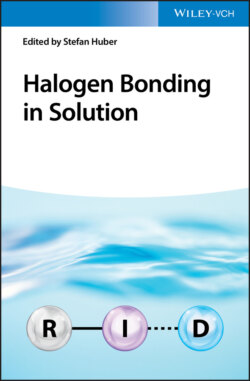Читать книгу Halogen Bonding in Solution - Группа авторов - Страница 27
1.4.2 Electrostatics of the Halogen Bond and the σ‐Hole
ОглавлениеOne description of the halogen bond is rooted in the electron distribution of an isolated molecule within a ground state. As a polarizable halogen forms a covalent bond with an electron‐withdrawing group, a rearrangement of electrons results in electron‐rich and electron‐poor regions within the newly formed species. Consequently, the halogen adopts a spheroid shape, with the radius of the halogen extending from the covalent bond to the outer surface being smaller than the radius measured normal to the covalent bond (Figure 1.1b). The term “polar flattening” is sometimes used to describe the oblate shape of the electron cloud resulting from the depletion of electronic charge at the end of the halogen [134] and has been demonstrated in a CSD study [135] as well as by experimental charge density analysis [136,137]. Polar flattening is not limited to halogens, but instead applies to all atoms covalently bound to another atom. Computationally mapping this distortion of electronic density has become a routine task and is achieved by measuring the ESP surface of a molecule. To better understand what ESP maps are depicting, it is necessary to outline their construction:
Equation 1.1 Electrostatic potential.
(1.1)
ESP is an application of Coulomb's law and is a physical property that can be determined experimentally by diffraction techniques or computationally [138]. Given an electron density function ρ(r′), V(r) is the ESP at any measured point r (Eq. (1.1)). ZA is the charge on the nucleus that is located at RA. |RA − r| is the distance of the positive charge from r, and likewise |r ′ − r| is the distance of the electronic charge from r, where r′ is the integration variable over all space. A positive V(r) indicates that effects by the nucleus are dominant or that the nucleus is not entirely shielded by the electron cloud. A negative V(r) indicates that the electron density, in the form of electron pairs, π‐bonds, etc., is dominant. ESP is frequently computed and viewed as a map covering the surface of a molecule. This surface is arbitrarily selected; however the most common surface to map is an outer contour of electron density, as it accurately encompasses lone pairs, strained bonds, and π‐electrons (Figures 1.2 and 1.14). Typically, the ρ(r′) = 0.001 au (electrons/bohr3) contour is used, but other similar contours at 0.0015 or 0.002 au will also achieve the same ends [138]. The ESP values along this surface are then set to a color gradient directly on the molecule in question, and the extremes are typically represented as blue and red (Figures 1.14 and 1.2). While ρ(r′) and V(r) are in Eq. (1.1), there is a distinct difference between the values. ρ(r′) is dependent on only electrons, while V(r) incorporates contributions from all nuclei and electrons. As such, Politzer and Murray caution: It cannot be assumed that high (low) electronic densities correspond to negative (positive) electrostatic potentials. The potential in a given region is the net result of negative contributions from the electrons and positive ones from the nuclei of the entire molecule, their effects of course being greater as they are closer to the region in question [140]. In other words, ESP maps do not necessarily correlate with overall electron density.
Disclaimer aside, ESP maps are still highly informative. They have helped justify the amphoteric behavior of halogens observed in the solid state, where electrophiles approach the halogen “side‐on” orthogonal to the CX bond and nucleophiles “head‐on” in line with the CX bond [4]. In particular, ESP studies by Politzer and Murray [5,141] led to the establishment of the σ‐hole concept, which has proven to be a widely valuable tool for conceptualizing the halogen bond and has contributed to the renaissance of other σ‐hole‐type interactions like chalcogen and pnictogen bonding [142]. Additionally, the ease of constructing ESP maps has led to their use in predicting relative halogen bond strength. For example, Politzer showed that the iodine VS,max values of iodobenzene derivatives largely positively correlate with their interaction energies with acetone [139] (Figure 1.14; Table 1.2). This relationship has been demonstrated a number of times theoretically [130,143] and has led to the use of VS,max values as predictors of solid‐state structures [72,75,144] and performance in solution [145]. Widespread application of VS,max and ESP maps has likely contributed to the halogen bond being mistakenly viewed as a purely electrostatic interaction; however other components are frequently important to fully describe the interaction [146]. For example, there are a number of cases where a more positive VS,max does not correlate with a stronger halogen bond [147].
Figure 1.14 Computed ESP maps on 0.001 au molecular surfaces of (a) iodobenzene, (b) meta‐difluoroiodobenzene, (c) ortho‐difluoroiodobenzene, and (d) pentafluoroiodobenzene. Color ranges, in kcal/mol, are red, greater than 20; yellow, between 20 and 10; green, between 10 and 0; and blue, negative. Black hemispheres denote the positions of the iodine VS,max.
Source: From Riley et al. [139]. © 2011 Springer Nature.
Table 1.2 Table of iodine VS,max values and interaction energies (ΔE) of iodobenzene derivatives with acetone.
Source: Adapted from Riley et al. [139]. Copyright 2011 John Wiley & Sons.
| Interaction angle | |||
| At (X⋯O<span class="dbondb"</span>C) = 180° | At optimum X⋯O<span class="dbondb"</span>C angle | ||
| System | VS,max (kcal/mol) | ΔE (kcal/mol) | ΔE (kcal/mol) |
| Iodobenzene | 17.3 | −2.44 | −3.22 |
| meta‐Difluoroiodobenzene | 26.1 | −3.38 | −4.13 |
| ortho‐Difluoroiodobenzene | 25.5 | −3.64 | −4.71 |
| para‐Fluoroiodobenzene | 35.9 | −4.88 | −5.97 |
